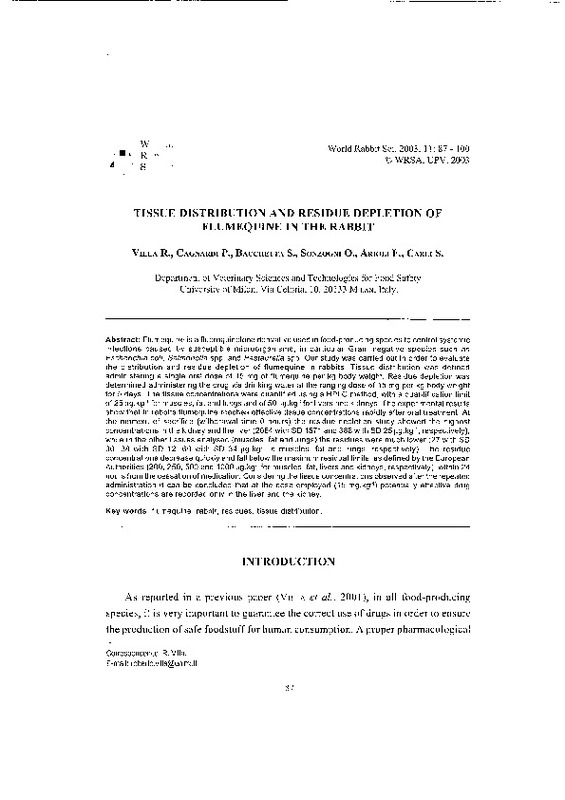JavaScript is disabled for your browser. Some features of this site may not work without it.
Buscar en RiuNet
Listar
Mi cuenta
Estadísticas
Ayuda RiuNet
Admin. UPV
TISSUE DISTRIBUTION AND RESIDUE DEPLETION OF FLUMEQUINE IN THE RABBIT
Mostrar el registro sencillo del ítem
Ficheros en el ítem
| dc.contributor.author | Villa, R.
|
|
| dc.contributor.author | Cagnardi, P.
|
|
| dc.contributor.author | Bacchetta, S.
|
|
| dc.contributor.author | Sonzogni, O.
|
|
| dc.contributor.author | Arioli, F.
|
|
| dc.contributor.author | Carli, S.
|
|
| dc.date.accessioned | 2011-02-23T11:15:26Z | |
| dc.date.available | 2011-02-23T11:15:26Z | |
| dc.date.issued | 2003 | |
| dc.identifier.issn | 1257-5011 | |
| dc.identifier.uri | http://hdl.handle.net/10251/9954 | |
| dc.description.abstract | [EN] Flumequine is a fluoroquinolone derivative used in food-producing species to control systemic infections caused by susceptible microorganisms, in particular Gram negative species such as Escherichia coli, Salmonella spp. and Pasteurella spp. Our study was carried out in order to evaluate the distribution and residue depletion of flumequine in rabbits. Tissue distribution was defined administering a single oral dose of 15 mg of flumequine per kg body weight. Residue depletion was determined administering the drug via drinking water at the ranging dose of 15 mg per kg body weight for 5 days. The tissue concentrations were quantified using a HPLC method, with a quantification limit of 25 mg.kg-1 for muscle, fat and lung and of 50 mg.kg-1 for liver and kidney. The experimental results show that in rabbits flumequine reaches effective tissue concentrations rapidly after oral treatment. At the moment of sacrifice (withdrawal time 0 hours) the residue depletion study showed the highest concentrations in the kidney and the liver (2064 with SD 1571 and 388 with SD 225 mg.kg-1, respectively), while in the other tissues analysed (muscle, fat and lung) the residues were much lower (27 with SD 30, 38 with SD 12, 60 with SD 34 mg.kg-1 in muscle, fat and lung, respectively). The residue concentrations decrease quickly and fall below the maximum residual limits, as defined by the European Authorities (200, 250, 500 and 1000 mg.kg-1 for muscle, fat, liver and kidney, respectively), within 24 hours from the cessation of medication. Considering the tissue concentrations observed after the repeated administration it can be concluded that at the dose employed (15 mg.kg-1) potentially effective drug concentrations are recorded only in the liver and the kidney. | es_ES |
| dc.language | Inglés | es_ES |
| dc.publisher | World Rabbit Science. ICTA. UPV | es_ES |
| dc.relation.ispartof | World Rabbit Science | |
| dc.rights | Reserva de todos los derechos | es_ES |
| dc.subject | Flumequine | es_ES |
| dc.subject | Rabbit | es_ES |
| dc.subject | Residues | es_ES |
| dc.subject | Tissue distribution | es_ES |
| dc.title | TISSUE DISTRIBUTION AND RESIDUE DEPLETION OF FLUMEQUINE IN THE RABBIT | es_ES |
| dc.type | Artículo | es_ES |
| dc.date.updated | 2011-02-23T10:54:48Z | |
| dc.identifier.doi | 10.4995/wrs.2003.500 | |
| dc.rights.accessRights | Abierto | es_ES |
| dc.description.bibliographicCitation | Villa, R.; Cagnardi, P.; Bacchetta, S.; Sonzogni, O.; Arioli, F.; Carli, S. (2003). TISSUE DISTRIBUTION AND RESIDUE DEPLETION OF FLUMEQUINE IN THE RABBIT. World Rabbit Science. 11(2):87-100. https://doi.org/10.4995/wrs.2003.500 | es_ES |
| dc.description.accrualMethod | SWORD | es_ES |
| dc.relation.publisherversion | https://doi.org/10.4995/wrs.2003.500 | |
| dc.description.upvformatpinicio | 87 | |
| dc.description.upvformatpfin | 100 | |
| dc.description.volume | 11 | |
| dc.description.issue | 2 | |
| dc.identifier.eissn | 1989-8886 | es_ES |








